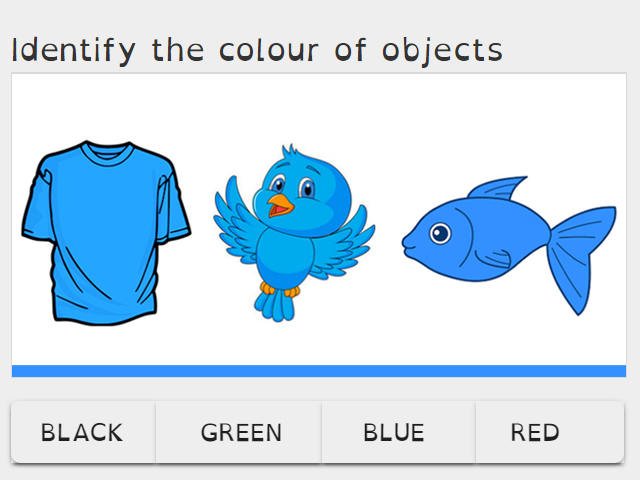Identifying Colours

This activity, Identifying Colours, helps parents to identify if their child has problems in distinguishing colours.
How is the activity organised?
Three objects are shown having the same colour and names of four colours are provided. The child is required to name the colour of the object shown.
The activity tests the child’s ability to recognize the following colours:
Black, blue, brown, cyan, green, grey, purple, red, rose and orange.
Parents can observe how their child does the activity. Does the child have any difficulty in doing the activity? Does the child have problems in identifying or naming any particular colour?
Why do children have problems in identifying or naming colours? Some of the causes behind a child’s difficulty with colours are listed below:
- Defective vision.
This is a general condition which comes in the way of seeing the colours.
- Colour blindness.
A small percentage of children are unable to distinguish colours. Monochromatic vision (seeing things only in shades of grey or seeing things only in black and white) is very rare.
Colour blindness is a condition where the eyes are unable to distinguish certain colours. The general vision is good but the difficulty lies in recognising colours. A person with colour blindness may not be able to distinguish between red or green or blue and yellow.There may be difficulty with other colours also. Or the difficulty is in seeing the shades of colours.
Colour blindness is a genetic condition. Unfortunately, there is no cure for colour blindness.
- The disconnect between the language area and the visual area
Research has shown that brain stores information about colours in one area and the information about names of the colours in another area. There is a visual system in the brain to record visual experiences. The visual system helps us to understand what we see. There is also a language system in the brain that is located away from the visual system. In some children the language system is not fully developed and they may have difficulty in storing information. Even if the information is stored, to name the colour of an object both the visual system and the language system should work together. When this doesn’t happen, it becomes difficult to name the colour of an object.
Remedial teaching can reduce the intensity of the difficulty.
Tips for you, the parents
Find out whether your child can identify and name colours. Ask questions in mother tongue (or a language the child is most comfortable with). Take oral tests. You can make an assessment of your child.
And if you think there is something amiss, the first step is to take your child to an ophthalmologist.If there are any problems with the child’s vision, the doctor would suggest appropriate remedy.
If there is nothing wrong with the vision of your child and if your child is not having colour blindness, then you can take the help of a special educator. Follow the remedial actions suggested by the special educator.
The following exercises/activities may prove useful.
- Identifying and naming colours.
Start teaching colours to your child one colour at a time.
Let us start with green colour. Show an object having only green colour and tell your child the name of the colour. Show another object having only green colour. Ask the child to name the colour. If the child cannot answer correctly, tell her/him the colour of the object is green. This process can be continued with some more objects having green colour. Use crayons/ colour pencils and ask the child to colour a picture green.
Next, teach the child another colour, say blue. The same steps as above are to be performed. Like this, teach the child to identify and name different colours.
- Sorting objects according to colour.
Sorting objects on the basis of colour is a good way to cement your child’s learning. Beads or buttons can be used for this purpose.
- A picture dictionary is useful to teach colours to kids. Buy a good picture dictionary. Search the net for picture dictionaries for kids. Several picture dictionaries can be downloaded free.
- Use objects at home
Vegetables and fruits can be used to teach colours. Your kitchen has colourful objects. The kitchen can be the teach-my-child-colours-lab!
- Colouring activity
The internet offers a wide variety of coloring activities. Free downloads are available. You can make your own colouring activity book for your child.

